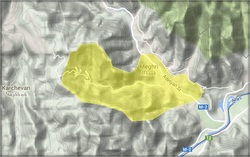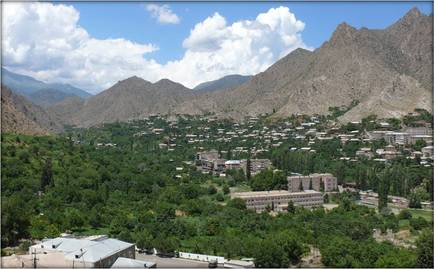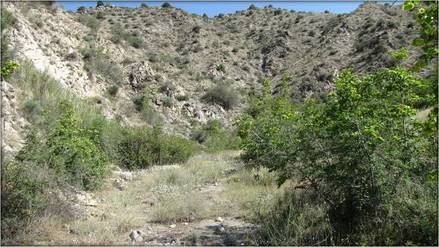|
General description:
The area (about 614 ha) is located in the Valley of Meghri River and eastern slopes of Karmirkar and Syvkar mountain ridges at elevations from 569 to 1223 m above sea level. The average slope steepness of the area is from 8˚ to 27˚. The area includes wormwood semi-desert, variegated semi-desert, and scrubland semi-desert, edges of juniper woodland, riparian scrubs and forest, and orchards. Dominant vegetation among herbs are wormwood (Artemisia sp.), Kochia sp., devil's-milk (Euphorbia sp.), feather grass (Stipa sp.), reed (Phragmites sp.); among scrubs are Atraphaxis sp., Christ's-thorn (Paliurus spina-christi), blackberry (Rubus sp.); among trees are juniper (Juniperus polycarpos) mulberry (Morus sp.), hackberry (Celtis glabrata), walnut (Juglans regia), fruit trees. The area is characterized by dry climate, with long hot and dry summers however riparian area is quite humid and the orchards are well irrigated. Description of butterfly diversity: Number of butterfly species in the area – 72 (31% of total number of species in Armenia). None of the species included in IUCN Red List, 4 species included in European Red List, and 3 of species are included in National Red Data Book. The species of national and international concern: Gegenеs nostrodamus, Papilio alexanor, Zegris eupheme, Pontia chloridice, Proterebia afra, Chazara briseis, Cupido argiades, Pseudophilotes vicrama, Iolana iolas, Polyommatus damonides. Threats: Since the area is situated in vicinity of urban zone, the major threats are related to habitat change due to conversion into arable lands and intensification of horticulture, as well as due to urbanization of the semi-desert areas and riparian zone. Another threat emerges from use of the area as dump for waste that comes from open pit mine and potentially from expansion of the open pit zone. These threats in the worse case destroy the habitat, but even in the less scale they affect butterfly fauna especially such species as Gegenes nostrodamus, Cupido argiades, and Iolana iolas, which inhabit the riparian zone and orchards and are represented in entire Armenia by few populations inhabiting this south-eastern district, Southern Swallowtail Papilio alexanor, and Pontia chloridice, which have patchy distribution in the region, and the Blue Polyommatus damonides, which is known in the world by two populations: one of them located in Nakhichevan (Western Azerbaijan enclave) and another one is within the Meghri area of Armenia. Armenian population of Polyommatus damonides was considered extinct due to habitat destruction by open pit mining, but recently its remains were rediscovered and require strong protection. Nevertheless the area has no current conservation status in Armenia. The most important step is inclusion of the area into Zangezur Biosphere Complex. Development of ecotourism in the area will support in sustainability of area protection. In 2014 following the process of identification of PBA in Armenia, the first step was done: the area was evaluated under Emerald Sites criteria, and a portion of Meghri PBA was included into Emerald Network. Butterfly-watching trail "Meghri" was designated, and personnel of the National Park was trained in species identification and trail guiding. The site is also included into Key Birding Sites of Armenia. |
|
© BirdLinks Armenia NGO, 2014
Charity Registration Number 03A968527
Charity Registration Number 03A968527





